|
Battle of Folck's Mill
Other Names: Battle of Cumberland
Location: Allegany County, Maryland
Campaign: Early's Raid and Operations against the B&O Railroad (June-August 1864)
Date(s):
August 1, 1864
Principal Commanders: Brig. Gen. Benjamin F. Kelly [US]; Brig.
Gen. John McCausland [CS]
Forces Engaged: Divisions
Estimated Casualties: 38 total
Result(s): Inconclusive
Description: After burning Chambersburg, Pennsylvania, on July
30, Johnson’s and McCausland’s cavalry brigades rode towards Cumberland, Maryland, to disrupt the B&O Railroad.
Brig. Gen. Benjamin Kelly organized a small force of soldiers and citizens to meet the Confederate advance. On August 1, Kelly
ambushed Rebel cavalrymen near Cumberland at Folck’s Mill, and skirmishing continued for several hours. Eventually the
Confederates withdrew.
| Battle of Folck's Mill Map |
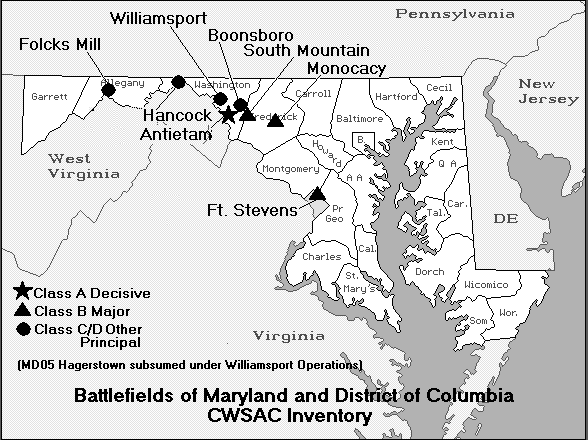
|
| Civil War Battle of Folck's Mill, Maryland |
Setting the Stage: Robert E. Lee was concerned about
Hunter's advances in the Valley during 1864, which threatened critical railroad lines and provisions for the Virginia-based
Confederate forces. He sent Jubal Early's corps to sweep Union forces from the Valley and, if possible, to menace Washington, D.C.,
hoping to compel Grant to dilute his forces against Lee around Petersburg, Virginia. Early was operating in the shadow of Thomas
J. "Stonewall" Jackson, whose 1862 Valley Campaign against superior forces was etched in Confederate history. (Stonewall Jackson's Valley Campaign: A History with Maps and Stonewall Jackson's Valley Campaign of 1862: Confederate Military
History) Early had a good start. He proceeded down the Valley without opposition, bypassed
Harpers Ferry, crossed the Potomac River, and advanced into Maryland. Grant dispatched a corps under Horatio G. Wright and other troops under George Crook to reinforce
Washington and pursue Early.
The Battle of Folck's Mill was one of several battles fought during Early's
Raid and Operations against the B&O Railroad (June-August 1864). Early's Operations against the B&O Railroad, often
times referred to as Early's Raid or Early's Maryland Campaign, was part of the Shenandoah Valley Campaigns of 1864 and was the second of three principal campaigns fought throughout the valley
region.
| Battle of Folck's Mill |
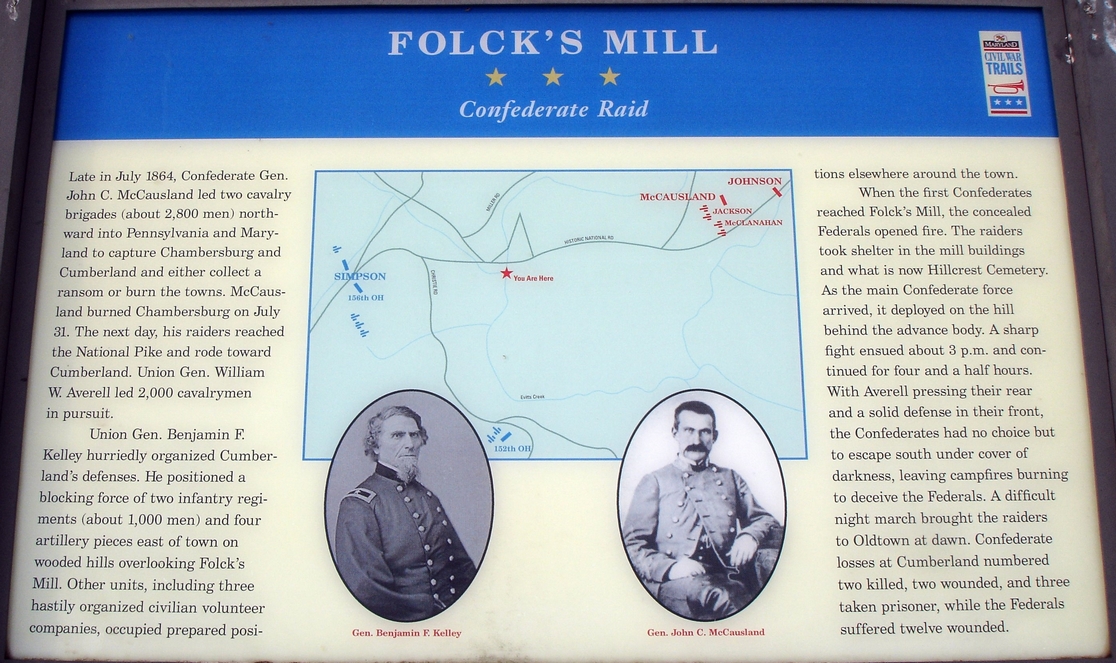
|
| Civil War Maryland Battle Map, courtesy hmdb.org |
| Battle of Folck's Mill History |
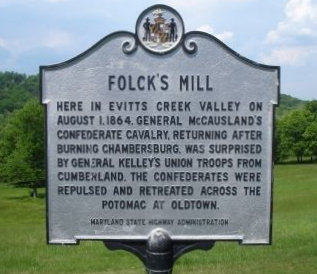
|
| Civil War Battle of Folck's Mill, History |
Folck's Mill is historically significant for its association with the Civil
War Battle of Folck's Mill. On August 1, 1864, Union troops commanded by General Benjamin F. Kelley engaged General John McCausland’s
Confederate forces as they advanced along the Baltimore Pike towards Cumberland after having burned the town of Chambersburg,
Pennsylvania, two days previously. The grist and saw mill complex of John Folck was located at the center of the action. The
Confederates took shelter behind the mill buildings as Kelley’s troops fired from the hillside above them; Folck's barn
was hit and burned down. The skirmish lasted through the afternoon and into early evening. As Union reinforcements approached,
the Confederates retreated into West Virginia. The Battle of Folck’s Mill, while resulting in relatively few casualties and only limited damage, is credited with
turning the Confederates away from Cumberland, and possibly sparing the city from Chambersburg's fate. The stone foundation
supported a three-story brick mill building, constructed in the early 19th century by Thomas Beall (of Ninian) and originally
known as Pleasant Mill. Jacob Hoblitzell, whose wife Amy Beall Hoblitzell was one of Thomas Beall's heirs, purchased the property
from the estate in 1819. After John Hoblitzell’s death in 1830, John Folck, Sr. purchased the mill property. In 1840,
John Folck, Jr. purchased the mill from the estate of his father. Around the turn of the 20th century, the Wolfe family purchased
the Folck’s Mill property and operated the business for a short time.
| Battle of Folck's Mill (present-day) |
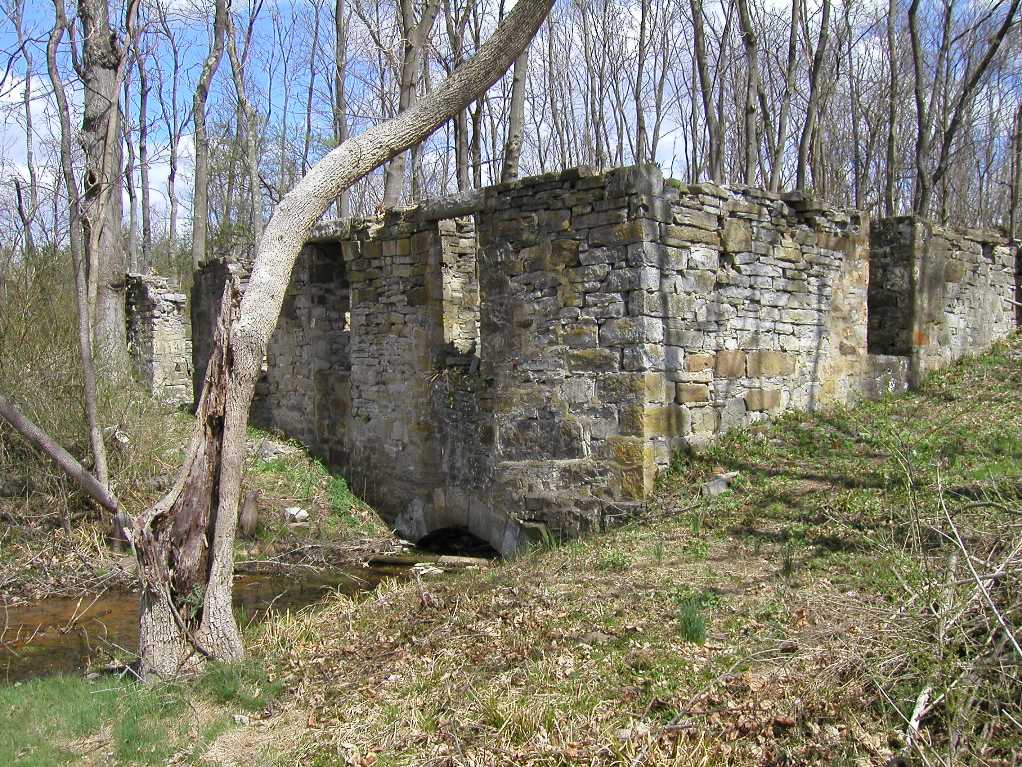
|
| Civil War Battle of Folck's Mill |
Battle: The
Battle of Folck's Mill, also known as the Battle of Cumberland, was a small cavalry engagement, fought August 1, 1864, in
northern Maryland, as part of the Valley Campaigns of 1864 during the American Civil War.
After burning Chambersburg, Pennsylvania on July 30, cavalry under Confederate
generals John McCausland and Bradley T. Johnson set out for western Maryland towards Cumberland, to disrupt traffic on the
Baltimore and Ohio (B&O) Railroad and to demand a ransom from the town or torch it as well. At 3 p.m. on August 1, the
Confederates arrived at Folck's Mill, east of Cumberland. There, Union Brig. Gen. Benjamin F. Kelley, with three divisions
of untested "100-days" troops and six pieces of artillery, met the Confederate advance. As the Confederates arrived at the
outskirts of town, Kelley's artillery fired on the cavalry. Due to a lack of familiarity with the local terrain and a lack
of knowledge concerning the strength of the force he was up against, McCausland decided against an assault and brought up
his own artillery. The gunners from both armies dueled until about 8 p.m., at which point McCausland withdrew, heading southeast
to Old Town on the Potomac River.
| Battle of Folck's Mill, Maryland |
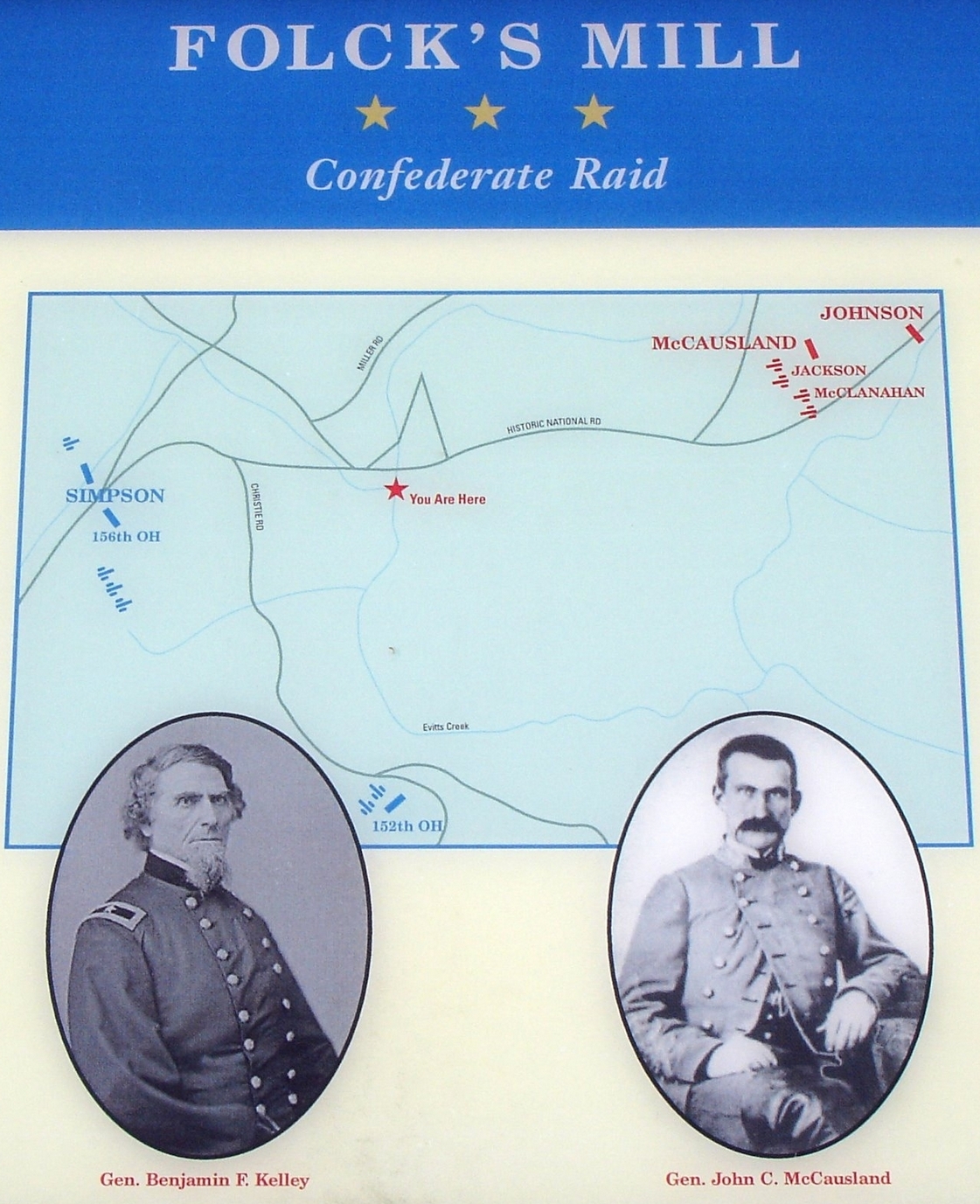
|
| Civil War Folck's Mill Battlefield Map, courtesy hmdb.org |
| Folck's Mill Map |
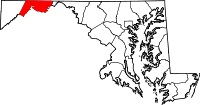
|
| Civil War Battle of Folck's Mill |
The following day the Confederates prepared to cross the Potomac and head
into West Virginia but found the bridges over the Chesapeake and Ohio Canal had been burned by Col. Israel Stough and his
regiment of 100-days troops. Stough deployed his force on the spit of land between the canal and river to contest the Confederate
advance towards the river. After initially repulsing a charge by the Confederate cavalry, Stough was forced to retreat across
the Potomac when the 21st Virginia successfully constructed a bridge and crossed the canal on his left flank. On the south
bank of the river the Federals took cover in a blockhouse on the B&O Railroad and in an armored ordnance train operated
by the Potomac Home Brigade that was stopped on the line. McCausland briefly considered an all out charge on the blockhouse,
but then thought it wise to first demand its surrender. The Federals in the blockhouse agreed to the terms of surrender, and
the Confederates crossed the river and headed to Springfield, West Virginia, where they rested until the 4th.
Aftermath and Analysis: Although the action around Cumberland
was tactically inconclusive, Kelley's stand likely saved the town from being burned and greater
damage being inflicted on the railroads. The stubborn resistance of Stough at the Potomac represented the first time McCausland's
force had been contested since burning Chambersburg.
| Battle of Folck's Mill, Maryland |
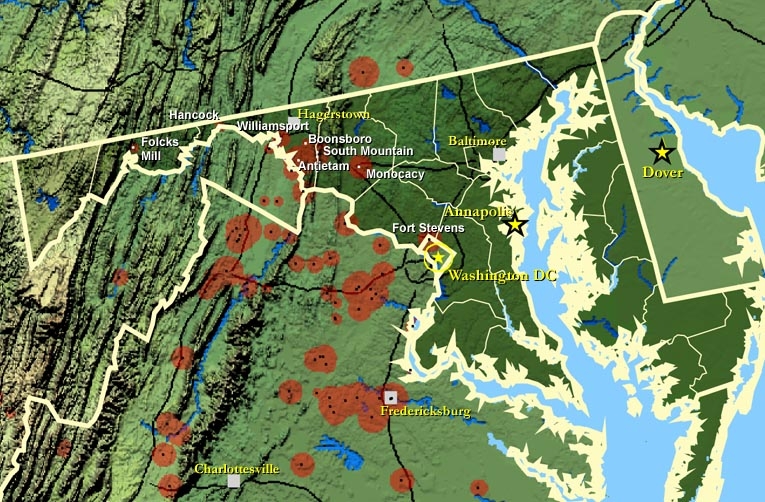
|
| Civil War Folck's Mill Battlefield Map |
| (Present-day) Historic Folck's Mill |

|
| Battle of Folck's Mill, Maryland |
Folck's Mill is a site containing the remains of a historic grist and
saw complex located near Cumberland, Allegany County, Maryland. The stone foundation of the mill, measuring 30 feet by 40
feet, is the principal feature of the site. It is historically significant for its association with the August 1, 1864, Civil
War Battle of Folck's Mill. In that battle, Union troops commanded by General Benjamin F. Kelley engaged General John McCausland’s
Confederate forces as they advanced along the Baltimore Pike towards Cumberland after having burned the town of Chambersburg,
Pennsylvania, two days previously.
Folck's Mill is marked by the remains of a large 19th-century grist and
saw milling complex on the floodplain of Evitts Creek, just north of Route 40 and I-68 east of Cumberland. The stone foundation
of the mill, measuring 30 x 40 feet, is the principal feature of the site. The foundation is built into a partially excavated
bank on its east and north sides; the south and west sides are fully exposed above grade and stand one story high. The foundation
is constructed of roughly dressed masonry. The west elevation has four openings: a wide entrance in the northernmost bay,
a window opening to its right, a former doorway (altered to a window), and another window opening in the southernmost bay.
The south wall has a single window opening. Water runs through a stone-lined trough along the interior south wall, and exits
through an arched, dressed-stone opening at the southern corner of the west wall. At the east end of the trough, a similar
arch appears at the top of the foundation, just above grade. The north wall is the least intact. An undated early-20th century
photograph shows the mill as a three-story, gable-roofed brick building resting on a stone foundation. Damage to the brickwork
in the southwest corner of the mill has been interpreted as having resulted from artillery fire during the skirmish. A short
distance north of the mill is a small square foundation constructed of poured concrete. Its function is unknown, but it appears
to postdate the Civil War. Other elements of the mill complex have vanished, including a barn which reportedly caught fire
during the battle and burned to the ground. It was listed on the National Register of Historic Places in 2008. Advance to:
Maryland Civil War History and Shenandoah Valley Campaigns: The Civil Battles.
(Sources listed below.)
Sources: National Park Service; Official Records of the Union and Confederate Armies; maryland.gov; Library
of Congress; Historical Marker Database.
|

